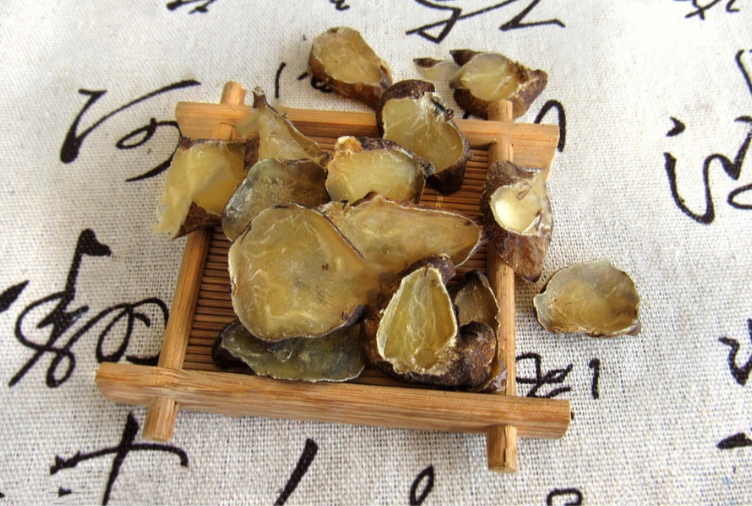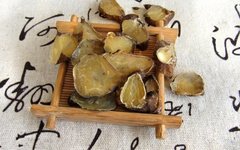
1. Aliases
Ce Zi, Hu Zhang, Shou Bai Fu Zi, Hei Fu Zi, Ming Fu Pian, Diao Fu, Chuan Fu Zi.
2. Plant Morphology
Perennial herb. The main root is spindle-shaped or inverted oval, usually with two connected, and cultivated varieties often have several thick lateral roots (child roots) around the main root. The stem is erect, 60-150 cm tall, sparsely covered with curved short hairs above the middle, with leaves growing at equal intervals and branching. The lower leaves wither during flowering. The middle leaves are alternate; leaf blades are leathery or papery, pentagonal, 6-11 cm long, 9-15 cm wide, with a shallow heart-shaped base, palmately three-lobed or deeply three-lobed near the base, the central lobe often broad rhombic, apex acute, sometimes nearly pinnately divided, the secondary lobes are triangular, and the lateral lobes are unevenly deeply lobed, the surface sparsely covered with short hairs, and the underside often sparsely covered with short soft hairs along the veins; petioles are 1-2.5 cm long, sparsely covered with short soft hairs. The terminal raceme is 6-25 cm long, with the inflorescence axis and flower stalks densely covered with curved short hairs; small bracts are present on the middle or lower part of the flower stalk; sepals are 5, blue-purple, with short soft hairs on the outside; the upper sepals are high helmet-shaped, 2-2.6 cm high, with an inconspicuous beak, lateral sepals are 1.6-2 cm long; petals are 2, hairless, about 11 mm long, lip about 6 mm long; slightly concave, spur 1-2.5 mm long, usually curled; stamens numerous, hairless or sparsely covered with short hairs; carpels 3-5, free. The follicle is 1.5-1.8 cm long; seeds are triangular, 3-3.2 mm long, densely covered with transverse membranous wings on two sides. Flowering period is June to August, fruiting period is August to October.
3. Distribution
Grows in mountainous grass slopes, shrubs, and forest edges. Distributed in Yunnan, Sichuan, Hubei, Guizhou, Hunan, Guangxi, Guangdong, Jiangxi, Zhejiang, Jiangsu, Anhui, Shaanxi, Henan, Shandong, Liaoning, and other provinces. Sichuan and Shaanxi are the main cultivation areas, where the main root (mother root) is processed into Chuan Wu, and the lateral root (child root) is processed into Fu Zi.
4. Harvesting and Processing
Harvested from late June to early August, removing the mother root, fibrous roots, and soil, commonly referred to as “mud Fu Zi,” processed into the following specifications: (1) Select large, uniform mud Fu Zi, wash clean, soak in edible gall water solution overnight, then add salt and continue soaking, taking out daily to dry, gradually extending the drying time until the surface of Fu Zi shows a large amount of crystallized salt (salt frost), and the texture becomes hard, commonly referred to as “salt Fu Zi.” (2) Take mud Fu Zi, wash clean according to size, soak in edible gall water solution for several days, boil with the soaking liquid until thoroughly cooked, remove, rinse with water, cut into slices about 0.5 cm thick, then soak in water, dye the slices with coloring liquid to a dark tea color, steam until an oily surface and gloss appear, then dry or continue drying, commonly referred to as “black shun slices.” (3) Select uniform-sized mud Fu Zi, wash clean, soak in edible gall water solution for several days, boil with the soaking liquid until thoroughly cooked, remove, peel off the outer skin, cut into slices about 0.3 cm thick, soak in water, steam thoroughly, and dry, commonly referred to as “white Fu slices.”
5. Properties of the Medicinal Material
Salt Fu Zi: conical, 4-7 cm long, 3-5 cm in diameter. Surface gray-black, covered with salt frost, with a depressed bud scar at the top, surrounded by tuberous protrusions of lateral roots or root scars. Heavy, cross-section gray-brown, with small voids filled with salt frost and polygonal formation ring patterns, the vascular bundles inside the ring are arranged irregularly. Slight odor, taste pungent and numbing, prickly on the tongue. Salt Fu Zi: longitudinally cut slices, wide at the top and narrow at the bottom, 1.7-5 cm long, 0.9-3 cm wide, 0.2-0.5 cm thick. Outer skin black-brown, cut surface dark yellow, oily and glossy, semi-transparent, with longitudinal vascular bundles. Hard and brittle, fracture surface is horn-like. Slight odor, bland taste. White Fu slices: no outer skin, yellow-white, semi-transparent, about 0.3 cm thick.
6. Nature and Flavor
Nature is hot, flavor is pungent and sweet, with significant toxicity. Enters the Heart (Xin) meridian, Kidney (Shen) meridian, and Spleen (Pi) meridian.
7. Efficacy and Functions
Revives Yang and rescues from collapse, supplements fire and assists Yang, disperses cold and alleviates pain. Classified as a warming interior medicine.
8. Clinical Applications
Dosage 3-15 grams, first decocted, long decoction. Used for Yang collapse, cold limbs with weak pulse, insufficient Heart Yang, chest obstruction and heart pain, cold and deficient vomiting and diarrhea, cold abdominal pain, Kidney Yang deficiency, impotence and cold uterus, cold water swelling, Yang deficiency with external pathogens, cold dampness obstructing pain.
9. Pharmacological Research
Cardiotonic; anti-myocardial ischemia; anti-shock; inhibits coagulation and anti-thrombus formation; anti-inflammatory; analgesic; local anesthesia; enhances humoral immunity; stimulates spontaneous contraction of intestinal tubes, inhibits gastric emptying; relieves asthma and relaxes bronchi; has effects against smooth muscle spasms.
10. Chemical Components
Fu Zi contains aconitine, mesaconitine, hypaconitine, talatizine, and dehydro-aconitine, as well as various alkaloids such as benzoylmesaconitine, new aconitine, fuziine, and others.
11. Contraindications
Contraindicated in cases of Yin deficiency with Yang excess, true heat with false cold, and in pregnant women. Alcohol should not be consumed while taking the medicine, and it is not advisable to use white liquor as a guide. Should not be used with Ban Xia, Gua Lou, Tian Hua Fen, Bei Mu, Bai Lian, Bai Ji.
12. Compatible Formulas
① For vomiting, sweating, fever with chills, and cold extremities: Licorice 60 grams (roasted), Dried Ginger 45 grams, Fu Zi (raw, peeled, broken into eight pieces) one piece. Combine these three ingredients, boil with three liters of water to obtain one liter and two deciliters, strain. Take warm. (From “Shang Han Lun” Si Ni Tang)
② For children’s diarrhea: Fu Zi 15 grams, He Zi fruit 30 grams, Zao Xin Tu 30 grams. Grind into powder. Form into pills the size of millet, take with clear rice soup. (From “Deng Shen Chuan Xin Lu” Fu He Wan)
③ For vomiting and nausea: One large Fu Zi, one piece of fresh ginger (finely shredded). Boil and grind into a paste, take with rice drink. (From “Experience Formulas”)
④ For Yin deficiency toothache: Grind raw Fu Zi into powder, mix with saliva and apply to the soles of the feet, extremely effective. (From “Hua Tuo Shen Yi Mi Chuan”)
⑤ For stroke with cold extremities: 0.3 grams of raw Fu Zi, 0.15 grams of Mu Xiang. Grind finely, take 1.5 grams each time, with two slices of ginger, decoct. (From “Pu Ji Fang” Fu Zi San)
The above is for reference only; please consult a physician for guidance.

Reviewed by: Pharmacist Lu
Edited by: San Qi Xiao Mei
Return to the main page Reply any of the keywords
to view the corresponding article
| Back Diagnosis | Face Diagnosis | Tongue Diagnosis | Sweat Diagnosis | Eye Diagnosis | Differentiation |
| Gua Sha | Cupping | Moxibustion | Acupressure | Foot Therapy | Meditation |
| Tapping | Stretching | Veins | Nails | Acne | Stones |
| Liver Cirrhosis | Home Feng Shui | San Fu Tie | Vinegar Soaked Eggs |
| Clever Tricks | Tests | Winter Disease Summer Treatment | Self-Healing |

